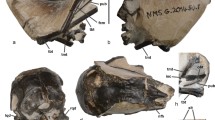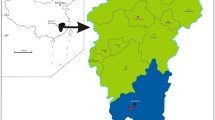Abstract
Oviraptorids are a group of specialized non-avian theropod dinosaurs that were generally one to 8 m in body length. New specimens of baby oviraptorids from the Late Cretaceous of Henan Province are some of the smallest individuals known. They include diagnostic characters such as the relative position of the antorbital fenestra and the external naris, distinct opening in the premaxilla anteroventral to the external naris, antorbital fossa partly bordered by premaxilla posterodorsally, lacrimal process of premaxilla does not contact the anterodorsal process of the lacrimal, parietal almost as long as frontal; in dorsal view, posterior margin forms a straight line between the postzygapophyses in each of the fourth and fifth cervicals; femur longer than ilium. They also elucidate the ontogenetic processes of oviraptorids, including fusion of cranial elements and changes in relative body proportions. Hind limb proportions are constant in oviraptorids, regardless of absolute body size or ontogenetic stage. This suggests a sedentary lifestyle that did not involve the pursuit of similar-sized prey. The functional implications for bite force and therefore dietary preferences are better understood through the study of such small animals. The comparison of the measurements of 115 skeletons indicates that oviraptorids maintain their hind limb proportions regardless of ontogenetic stage or absolute size, which is a pattern seen more commonly in herbivores than in carnivores. This may weakly support the hypothesis that oviraptorids are herbivores rather than active carnivores.





Similar content being viewed by others
References
Barsbold R (1976) On a new Late Cretaceous family of small theropods (Oviraptoridae fam. n.) of Mongolia. Doklady Akademia Nauk SSSR 226(3):685–688, in Russian
Barsbold R, Maryanska T, Osmólska H (1990) Oviraptorosauria. In Weishampel DB, Dodson P, Osmólska H (eds) The Dinosauria, 1st ed. Univ. of California Press, Berkeley, pp 249–258
Barsbold R, Osmólska H, Watabe M, Currie PJ, Tsogtbaatar K (2000) A new oviraptorosaur (dinosaur, theropod) from Mongolia: the first dinosaur with a pygostyle. Acta Palaeontol Polonica 45:97–106
Benson RBJ, Butler RJ, Carrano MT, O’Connor PM (2011) Air-filled postcranial bones in theropod dinosaurs: physiological implications and the ‘reptile’–bird transition. Biol Rev 87:168–193
Bureau of Geology and Mineral Resources of Henan Province (1989) Regional Geology of Henan Province. Geological Publishing House, Beijing, pp 1–772
Campione NE and Evans DC (2012) A universal scaling relationship between body mass and proximal limb bone dimensions in quadrupedal terrestrial tetrapods. BMC Biology 10:60. http://www.biomedcentral.com/1741-7007/10/60
Carpenter K (1982) Baby dinosaurs from the Late Cretaceous Lance and Hell Creek formations and a description of a new species of theropod. Contrib Geol Univ Wyoming 20:123–134
Christiansen P (1999) Long bone scaling and limb posture in non-avian theropods: evidence for differential allometry. J Paleontol 19:666–680
Clark JM, Norell MA, Chiappe LM (1999) An oviraptorid skeleton from the late Cretaceous of Ukhaa Tolgod, Mongolia, preserved in an avian-like brooding position over an oviraptorid nest. Am Mus Novit 3265:1–36
Clark JM, Norell MA, Barsbold R (2001) Two new oviraptorids (Theropoda: Oviraptorosauria), Upper Cretaceous Djadokhta Formation, Ukhaa Tolgod, Mongolia. J Vert Paleontol 21(2):209–213
Clark JM, Norell MA, Rowe T (2002) Cranial anatomy of Citipati osmolskae (Theropoda, Oviraptorosauria), and a reinterpretation of the holotype of Oviraptor philoceratops. Am Mus Novit 3364:1–24
Coria RA, Currie PJ (2006) A new carcharodontosaurid (Dinosauria: Theropoda) from the Upper Cretaceous of Argentina. Geodiversitas 28:71–118
Cracraft J (1971) Caenagnathiformes: Cretaceous birds convergent in jaw mechanism to dicynodont reptiles. J Paleontol 45:805–809
Currie PJ (1978) The orthometric linear unit. Journal of Paleontology 52:964–971
Currie PJ (1985) Cranial anatomy of Stenonychosaurus inequalis (Saurischia, Theropoda) and its bearing on the origin of birds. Can J Earth Sci 22:1643–1658
Currie PJ (2003a) Cranial anatomy of tyrannosaurid dinosaurs from the Late Cretaceous of Alberta, Canada. Acta Palaeontol Polonica 48(2):191–226
Currie PJ (2003b) Allometric growth in tyrannosaurids (Dinosauria: Theropoda) from the Upper Cretaceous of North America and Asia. Can J Earth Sci 40:651–665
Currie PJ, Russell DA (1988) Osteology and relationships of Chirostenotes (Saurischia, Theropoda) from the Judith River (Oldman) Formation of Alberta, Canada. Can J Earth Sci 25:972–986
Currie PJ, Zhao XJ (1993) A new large theropod (Dinosauria, Theropoda) from the Jurassic of Xinjiang, People’s Republic of China. Can J Earth Sci 30:2037–2081
Currie PJ, Godfrey SJ, Nessov L (1993) New caenagnathid (Dinosauria: Theropoda) specimens from the Upper Cretaceous of North America and Asia. Can J Earth Sci 30:2255–2272
Farlow JO, Hurlburt GR, Elsey RM, Britton AC, Langston WJR (2005) Femoral dimensions and body size of Alligator mississippiensis: estimating the size of extinct Mesoeucrocodylians. J Vertebr Paleontol 25(2):354–369
He T, Zhou ZH, Wang XL (2008) A new genus and species of caudipterid dinosaur from the Lower Cretaceous Jiufotang Formation of western Liaoning, China. Vertebrata PalAsiatica 46(3):178–189
Holtz TR (1994) The arctometatarsalian pes, an unusual structure of the metatarsus of Cretaceous theropoda (Dinosauria: Saurischia). J Vertebr Paleontol 14:480–519
Horner JR, Makela R (1979) Nest of juveniles provides evidence of family structure among dinosaurs. Nature 282:296–298
Ji Q, Currie PJ, Norrell MA, Ji SA (1998) Two feathered dinosaurs from northeastern China. Nature 393:753–761
Longrich NR, Currie PJ, Dong ZM (2010) A new oviraptorid (Dinosauria: Theropoda) from the Upper Cretaceous of Bayan Mandahu, Inner Mongolia. Palaeontology 53:945–960
Lü JC (2002) A new oviraptorosaurid (Theropoda: Oviraptorosauria) from the Late Cretaceous of southern China. J Vertebr Paleontol 22(4):871–875
Lü JC, Tomida Y, Azuma Y, Dong ZM, Lee YN (2004) New oviraptorid dinosaur (Dinosauria: Oviraptorosauria) from the Nemegt Formation of southwestern Mongolia. Bull Natl Sci Mus, Tokyo, Ser C 30:95–130
Lü JC, Tomida Y, Azuma Y, Dong ZM, Lee YN (2005) Nemegtomaia gen. nov., a new generic name for the oviraptorosaurian dinosaur Nemegtia Lü et al., 2004. Bulletin of the National Science Museum, Tokyo, Ser. C 31:51
Lü JC, Zhang BK (2005) A new oviraptorid (Theropod: Oviraptorosauria) from the Upper Cretaceous of the Nanxiong Basin, Guangdong Provinces of southern China. Acta Palaeontol Sinica 44(3):412–422
Lü JC, Xu L, Jiang XJ, Jia SH, Li M, Yuan CX, Zhang XL, Ji Q (2009) A preliminary report on the new dinosaurian fauna from the Cretaceous of the Ruyang Basin, Henan Province of central China. J Paleontol Soci Korea 25(1):43–56
Lü JC, Xu L, Zhang XL, Ji Q, Jia SH, Hu WY, Zhang JM, Wu YH (2007) New dromaesoaurid dinosaur from the Late Cretaceous Qiupa Formation of Luanchuan area, western Henan, China. Geo Bull China 26(7):777–786
Lü JC (2005) Oviraptorid dinosaurs from southern China. Geological Publishing House, Beijing, pp. 208
Lü JC, Dong ZM, Azuma Y, Barsbold R, Tomida Y (2002) Oviraptorosaurs compared to birds. In: Z. Zhou, F. Zhang (eds) Proceedings of the 5th Symposium of the Society of Avian Paleontology and Evolution, Science Press, pp 175–189
Makovicky PJ, Sues HD (1998) Anatomy and phylogenetic relationships of the theropod dinosaur Microvenator celer from the Lower Cretaceous of Montana. Am Mus Novit 3240:1–27
Norell MA, Clark JM, Dashzeveg D, Barsbold R, Chiappe LM, Davidson AR, Mckenna MC, Perle A, Novacek MJ (1994) A theropod dinosaur embryo and the affinities of the Flaming Cliffs Dinosaur eggs. Science 266:779–782
Norell MA, Clark JM, Chiappe LM, Dashzeveg D (1995) A nesting dinosaur. Nature 378:774–776
Osborn HF (1924) Three new Theropoda, Protoceratops zone, central Mongolia. Am Mus Novit 144:1–12
Osmólska H (1976) New light on the skull anatomy and systematic position of Oviraptor. Nature 262:683–684
Osmólska H, Currie PJ, Barsbold R (2004) In: Weishampel DB, Dodson P, Osmólska H (eds) The Dinosauria, 2nd edn. University of California Press, Berkeley, pp 165–183
Ostrom JH (1961) Cranial morphology of the hadrosaurian dinosaurs of North America. Bull Am Mus Nat Hist 122(2):33–186
Ostrom JH (1964) A functional analysis of jaw mechanics in the dinosaur Tricceratpos. Postilla 88:1–35
Ostrom JH (1966) Functional morphology and evolution of the ceratoposian dinosaurs. Evolution 20:290–308
Rosenberg DS, Dodson P (1996) An allometric analysis of dinosaur skeletons. J Vertebr Paleontol 16:61A
Russell DA (1970) Tyrannosaurs from the Late Cretaceous of western Canada. National Museum of Natural Sciences, Publications in Palaeontology 1:1–34
Smith D (1992) The type specimen of Oviraptor philoceratops, a theropod dinosaur from the Upper Cretaceous of Mongolia. Neues Jahrbuch für Paläontology und Geologie, Abhandlungen 186(3):365–388
Snively E, Henderson DM, Phillips DS (2006) Fused and vaulted nasals of tyrannosaurid dinosaurs: Implications for cranial strength and feeding mechanics. Acta Palaeontologica Polonica 51(3):435–454
Sternberg RM (1940) A toothless bird from the Cretaceous of Alberta. J Paleontol 14(1):81–85
Sues HD (1997) On Chirostenotes, a Late Cretaceous oviraptorosaur (Dinosauria: Theropoda) from western North America. J Vertebr Paleontol 17:698–716
Swofford DL (2002) Paup*. Phylogenetic analysis using parsimony (*and other methods). Sinauer Associates, Sunderland
Wood BA (1979) Relationship between body size and long bone lengths in Pan ang Gorilla. Am J Phys Anthropol 50(1):23–25
Wu XC, Russell AP (1997) Functional morphology. In: Currie PJ, Padian K (eds) Encyclopedia of dinosaurs. Academic Press, San Diego, pp 258–268
Xu X, Cheng YN, Wang XL, Chang CH (2002) An unusual oviraptorosaurian dinosaur from China. Nature 419:291–293
Xu X, Tan QW, Wang JM, Zhao XJ, Tan L (2007) A gigantic bird-like dinosaur from the Late Cretaceous of China. Nature 447:844–847
Xu X, Han FL (2010) A new oviraptorid dinosaur (Theropoda: Oviraptorosauria) from the Upper Cretaceous of China. Vertebr PalAsia 48:11–18
Acknowledgments
We thank Yoshitsugu Kobayashi (Hokkaido University Museum, Hokkaido University, Japan) for making the thin section of the rib of HGM 41HIII-0107. Eva Koppelhus provided support for measuring and photographing the specimens. This study was supported by Natural Science Foundation of China grants (41272022; 40872017), and the study of dinosaur faunas from western and southern Henan Province (2006).
Author information
Authors and Affiliations
Corresponding author
Additional information
Communicated by: Robert Reisz
Electronic supplementary material
Below is the link to the electronic supplementary material.
ESM 1
(PDF 381 kb)
Rights and permissions
About this article
Cite this article
Lü, J., Currie, P.J., Xu, L. et al. Chicken-sized oviraptorid dinosaurs from central China and their ontogenetic implications. Naturwissenschaften 100, 165–175 (2013). https://doi.org/10.1007/s00114-012-1007-0
Received:
Revised:
Accepted:
Published:
Issue Date:
DOI: https://doi.org/10.1007/s00114-012-1007-0




